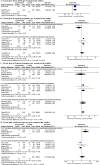Does time-lapse imaging have favorable results for embryo incubation and selection compared with conventional methods in clinical in vitro fertilization? A meta-analysis and systematic review of randomized controlled trials
- PMID: 28570713
- PMCID: PMC5453598
- DOI: 10.1371/journal.pone.0178720
Does time-lapse imaging have favorable results for embryo incubation and selection compared with conventional methods in clinical in vitro fertilization? A meta-analysis and systematic review of randomized controlled trials
Abstract
Objective: The present study aimed to undertake a review of available evidence assessing whether time-lapse imaging (TLI) has favorable outcomes for embryo incubation and selection compared with conventional methods in clinical in vitro fertilization (IVF).
Methods: Using PubMed, EMBASE, Cochrane library and ClinicalTrial.gov up to February 2017 to search for randomized controlled trials (RCTs) comparing TLI versus conventional methods. Both studies randomized women and oocytes were included. For studies randomized women, the primary outcomes were live birth and ongoing pregnancy, the secondary outcomes were clinical pregnancy and miscarriage; for studies randomized oocytes, the primary outcome was blastocyst rate, the secondary outcome was good quality embryo on Day 2/3. Subgroup analysis was conducted based on different incubation and embryo selection between groups.
Results: Ten RCTs were included, four randomized oocytes and six randomized women. For oocyte-based review, the pool-analysis observed no significant difference between TLI group and control group for blastocyst rate [relative risk (RR) 1.08, 95% CI 0.94-1.25, I2 = 0%, two studies, including 1154 embryos]. The quality of evidence was moderate for all outcomes in oocyte-based review. For woman-based review, only one study provided live birth rate (RR 1,23, 95% CI 1.06-1.44,I2 N/A, one study, including 842 women), the pooled result showed no significant difference in ongoing pregnancy rate (RR 1.04, 95% CI 0.80-1.36, I2 = 59%, four studies, including 1403 women) between two groups. The quality of the evidence was low or very low for all outcomes in woman-based review.
Conclusions: Currently there is insufficient evidence to support that TLI is superior to conventional methods for human embryo incubation and selection. In consideration of the limitations and flaws of included studies, more well designed RCTs are still in need to comprehensively evaluate the effectiveness of clinical TLI use.
Conflict of interest statement
Figures
References
-
- Ferraretti AP, Goossens V, Kupka M, Bhattacharya S, de Mouzon J, Castilla JA, et al. Assisted reproductive technology in Europe, 2009: results generated from European registers by ESHRE. Hum Reprod. 2013;28:2318–2331. doi: 10.1093/humrep/det278 - DOI - PubMed
-
- Montag M, Toth B, Strowitzki T. New approaches to embryo selection. Reprod Biomed Online. 2013;27:539–546. doi: 10.1016/j.rbmo.2013.05.013 - DOI - PubMed
-
- Gleicher N, Kushnir VA, Barad DH. Is it time for a paradigm shift in understanding embryo selection? Reprod Biol Endocrinol. 2015;13:3 doi: 10.1186/1477-7827-13-3 - DOI - PMC - PubMed
-
- Chamayou S, Patrizio P, Storaci G, Tomaselli V, Alecci C, Ragolia C, et al. The use of morphokinetic parameters to select all embryos with full capacity to implant. J Assist Reprod Genet. 2013;30:703–710. doi: 10.1007/s10815-013-9992-2 - DOI - PMC - PubMed
-
- Cruz M, Garrido N, Herrero J, Perez-Cano I, Munoz M, Meseguer M. Timing of cell division in human cleavage-stage embryos is linked with blastocyst formation and quality. Reprod Biomed Online. 2012;25:371–381. doi: 10.1016/j.rbmo.2012.06.017 - DOI - PubMed
Publication types
MeSH terms
LinkOut - more resources
Full Text Sources
Other Literature Sources
Medical




